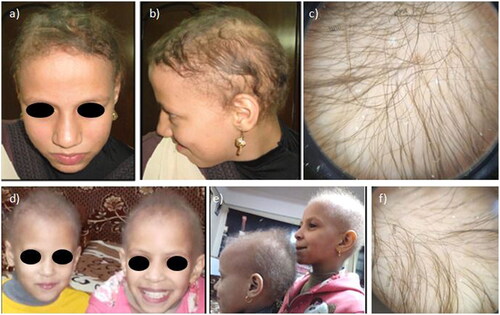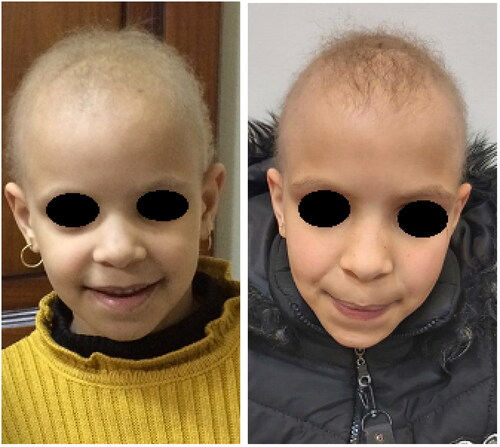Abstract
Background: Hereditary hypotrichosis simplex is a rare genetic hair disease that affects the scalp. Failure to grow normal hair in terms of length and density is the main complaint of patients. Diagnosis usually established by exclusion of other congenital hair and other ectodermal disorders. Till now, no satisfactory treatment was used for the condition.
Report: A 14 year old patient with hypotrichosis simplex was treated with combined platelet rich plasma injection and topical minoxidil 2% with marked improvement.
Conclusion: While no satisfactory treatment presents for this condition, the use of platelet rich plasma injection can add new hope for hypotrichosis simplex patients.
Review
Congenital absence or sparsity of hair can be a sign of many hereditary syndromes. Hair affection can be associated with other abnormalities or, less commonly, the only detectable abnormality and termed as hereditary hypotrichosis simplex (HHS). It is a rare genotrichosis characterized by hair follicle miniaturization. HHS may affect scalp only or extends to other body hair. Typically, hypotrichosis simplex is not associated with other systemic abnormalities or hair shaft defects (Citation1).
Hypotrichosis simplex of the scalp was first described in 1974 by Toribio and Quinones (Citation2). Affected individuals are usually born with apparently normal hair and changes start during early childhood which progress with age. Hair becomes thin, sparse and unable to grow over few centimeters. By the second or third decade, patients may experience complete baldness (Citation3).
Hypotrichosis simplex can be both autosomal recessive and dominant genetic disorder. It occurs due to mutation of corneodesmosin (CDSN) gene. CDSN gene is expressed in inner root sheath. The abrupt protein accumulates within the hair follicle causing disruption of its normal function (Citation4).
Platelet-rich plasma (PRP), is a relatively new treatment modality that has been emerged in practice to promote healing. PRP is used in cases of hair loss as it increases follicular and perifollicular angiogenesis through the increase of vascular endothelial growth factor (VEGF) and platelet derived growth factor (PDGF) levels. It also has an anti apoptotic effect which prolongs the survival of dermal papilla cells during the hair cycle. Moreover, the up regulation of fibroblast growth factor (FGF)-7/β-catenin signaling pathways with PRP treatment is suggested to stimulate hair growth by inducing follicular stem cell differentiation as well as prolonging the anagen phase of the hair growth cycle (Citation5).
Report
We report 3 Egyptian female girls from the same family, diagnosed with hypotrichosis simplex. Patient1 was a 14 year old female, born to consanguineous parents and she suffered from sparse hair that failed to grow over few centimeters since birth (). Same condition affected her two cousins; the second and third patients, who were 10 and 8 year old sisters born to consanguineous parents ().
Figure 1. Clinical and dermoscopic picture of the affected patients and her cousins. (a,b,d,e) patients presented with thinning of scalp hair which is non growing since birth, (c,f) scalp dermoscopy showing normal hair shaft with variation in hair thickness and lowered density.

Hair examination of the three patients revealed that hypotrichosis was limited to scalp and no affection of other ectodermal tissues as nail, teeth or sweat. Hair was thin, short and not easily plugged with negative pull test. Dermoscopic examination showed that most of the pulled hairs were in anagen phase with no obvious alteration of hair shaft or internal root sheath. All these findings go well with the case of HHS reported ()
After exclusion of other causes of congenital hypotrichosis, diagnosis of hereditary hypotrichosis simplex was established. All patients were advised to apply minoxidil 2%, 3 puffs twice daily. Patient 1 received platelet rich plasma scalp injection once a month in addition to the daily minoxidil for 12 months duration. First, PRP was prepared by obtaining 10 cm venous blood extracted in the tubes of Zoom Italy PRP Kits for hair regeneration - UNEX-MED Company. These kits were based on closed system without using any activator. Automated centrifuge specific for PRP extraction was used. Scalp was disinfected with pure alcohol then topical anesthetic cream was applied for 40–60 min under occlusive method. Eventually, PRP was injected into the scalp. The sessions were well tolerated, with mild pain and erythema.
Follow up showed significant improvement with combined minoxidil and PRP () treatment, compared to mild improvement in patients treated with minoxidil only (). After 12 months of continuous PRP and minoxidil treatment, patient1 stopped PRP sessions. She started noticing hair shedding 3 months after PRP suspension and the improvement was declined despite persistent use of topical minoxidil ().
Discussion
Hypotrichosis simplex is a rare hereditary hair disorder which is manifested by either isolated scalp hair affection or involves or body hair. The condition usually starts in the first decade of life. Diagnosis and treatment of HHS is challenging and in the absence of genetic testing, diagnosis of HHS is established by exclusion. Short hair occurs with different etiological background; it can be due to shaft breakage, falling at certain length or true inability to grow normal healthy hair. Good examination of other ectodermal tissues is mandatory to exclude other syndromes e.g. ectodermal dysplasia. Other metabolic disorders may give the same picture of fine hair. Some acquired disorders should be ruled out e.g. loose anagen syndrome which differs in the easily pulled hairs as well as hair bulb abnormalities (Citation3).
Marie Unna hypotrichosis is a similar condition that should be differentiated from HHS. It is characterized by coarse wiry hair which shows shaft abnormalities with microscopic examination (Citation6).
Absence of other systemic or ectodermal abnormalities with positive family history is essential for the diagnosis of HHS. But in isolated cases the diagnosis of sporadic hypotrichosis simplex of scalp can be done only by ruling out other possible causes of congenital and hereditary hypotrichosis.
Children with congenital hypotrichosis generally do not improve with puberty (Citation7). There is no specific treatment for hypotrichosis simplex, counseling is the mainstay of management (Citation8). However, few trials have been demonstrated in literature (Citation6,Citation9). Minoxidil was used with improvement of a case of congenital hypotrichosis due to autosomal recessive wooly hair. The improvement was explained by the effect of the drug on cell growth, anagen duration and follicular size (Citation10). Recently, low dose sublingual minoxidil used in treatment of diffuse congenital hereditary generalized hypotrichosis with associated hair shaft fragility in a 5-year-old girl (Citation11). Topical gentamicin is another modality which has been used in treatment of cases with HHS (Citation9). Authors claimed that gentamicin can improve corneodesmosin synthesis and attenuate hair affection severity in patients with HHS (Citation8). In the current trial, PRP was used in addition to minoxidil and showed good results. These findings can be explained by the stimulatory effect of the PRP growth factors on the hair follicle which improves its survival, activity, and counteracts the suppressive effect of the truncated proteins accumulated within the hair follicle interfering with its normal function.
Conclusion
In this study, PRP injection was used as a treatment of HHS and it showed marked improvement in our patient. Further future study on a large number of patients having this rare disease with a control group is recommended.
Disclosure statement
No potential conflict of interest was reported by the author(s).
Additional information
Funding
References
- Koslu A, Ekmekci T, Cetincelik U. A case of hereditary hypotrichosis simplex. J Eur Acad Dermatol Venereol. 2006;20(9):1150–1151.
- Toribio J, Quinones PA. Hereditary hypotrichosis simplex of the scalp. Br J Dermatol. 1974;91(6):687–696.
- de Berker D. Congenital hypotrichosis. Int J Dermatol. 1999;38(S1):25–33.
- Shimomura Y. Congenital hair loss disorders: rare, but not too rare. J Dermatol. 2012;39(1):3–10.
- Gentile P, Garcovich S, Bielli A, et al. The Effect of Platelet-Rich plasma in hair regrowth: a randomized Placebo-Controlled trial. Stem Cells Transl Med. 2015;4(11):1317–1323.
- Farah RS, Holahan HM, Moye MS, et al. Hereditary hypotrichosis simplex of the scalp. Cutis. 2017;100(1):E12–E14.
- Oberlin KE, Maddy AJ, Martínez-Velasco MA, et al. Short anagen syndrome: case series and literature review. Pediatr Dermatol. 2018;35(3):388–391.
- Kibtiar M, Akther R, Islam MM, et al. Congenital Hypotrichosis simplex: a case report. Bangladesh J Child Heal. 2019;43(1):59–61.
- Peled A, Samuelov L, Sarig O, et al. Treatment of hereditary hypotrichosis simplex of the scalp with topical gentamicin. Br J Dermatol. 2020;183(1):114–120.
- Tanahashi K, Sugiura K, Akiyama M. Topical minoxidil improves congenital hypotrichosis caused by LIPH mutations. Br J Dermatol. 2015;173(3):865–866.
- Willems A, Sinclair R. Diffuse congenital hypotrichosis simplex with associated hair shaft fragility. Australas J Dermatol. 2021;63(1):e96–e97.



